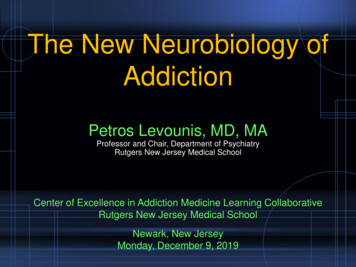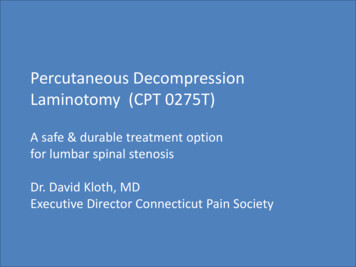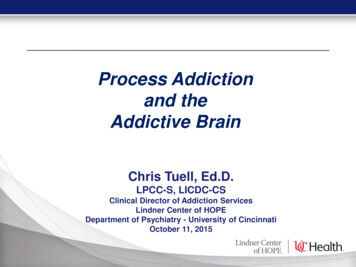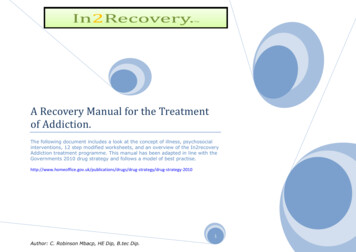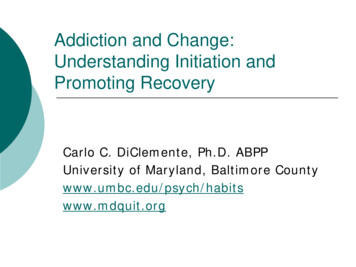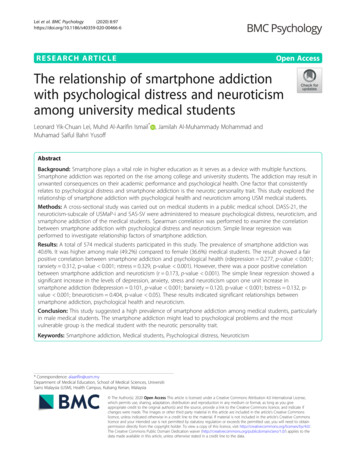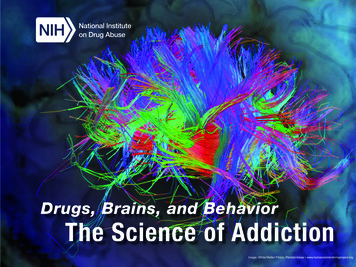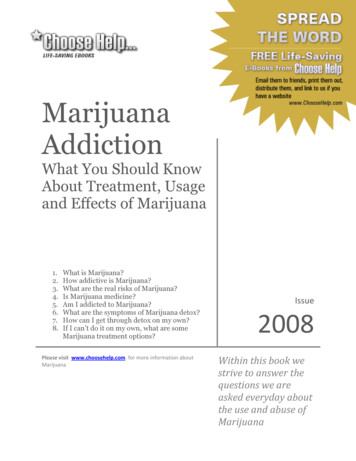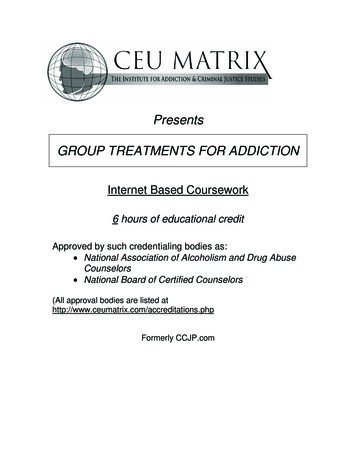
Transcription
PresentsGROUP TREATMENTS FOR ADDICTIONInternet Based Coursework6 hours of educational creditApproved by such credentialing bodies as: National Association of Alcoholism and Drug AbuseCounselors National Board of Certified Counselors(All approval bodies are listed rly CCJP.com
GROUP TREATMENTS FOR ADDICTIONWelcome to the growing family of coursework participants at CEU Matrix - TheInstitute for Addiction and Criminal Justice Studies.This distance learning course package was developed for CEU Matrix by DennisC. Daley, PhD. It is based on information found in the manual Group Treatmentsfor Addiction, Daley Publications.This package contains the course materials, along with the post test andevaluation that are required to obtain the certificate of completion for the course.You may submit your answers online to receive the fastest response and accessto your online certificate of completion. To take advantage of this option, simplyaccess the Student Center at http://www.ceumatrix.com/studentcenter; login as aReturning Customer by entering your email address, password, and click on'Take Exam'. For your convenience, we have also enclosed an answer sheetthat will allow you to submit your answers by mail or by fax.Copyright NoticeThe documents and information on this Web site, excluding the GroupTreatments for Addiction manual, are copyrighted materials of CEUMatrix, LLC,and its information providers. Reproduction or storage of materials retrievedfrom this service is subject to the U.S. Copyright Act of 1976, Title 17 U.S.C. Copyright 2010 CEUMatrix, LLC.All rights reserved. Do not duplicate or redistribute in any form. Printed in theUnited States of America. No portion of this publication may be reproduced inany manner without the written permission of the publisher.
About the Instructor:Dennis C. Daley, Ph.D., is a Professor of Psychiatry, and Chief of AddictionMedicine Services at Western Psychiatric Institute and Clinic (WPIC) of theUniversity of Pittsburgh Medical Center. He oversees a large continuum of careat Addiction Medicine Services (AMS), which includes over twenty-five treatment,prevention and intervention programs, training programs for psychiatric residents,medical students and graduate students in behavioral health.Dr. Daley has been or is currently an investigator, trainer and/or consultant onnumerous research studies at WPIC sponsored by the National Institute on DrugAbuse and National Institute on Alcohol Abuse and Alcoholism related totreatment of individuals with substance use disorders and mood disorders. He iscurrently a trainer and consultant on a NIDA sponsored study of bipolarsubstance abusers at Harvard Medical School (Roger Weiss, MD, PI). Dr. Daleyand colleagues at AMS are currently involved in seven research projects. Hisresearch interests are in the areas of addiction, mood disorders and addiction,and adherence to treatment.Using the Homepage for CEU Matrix - The Institutefor Addiction and Criminal Justice StudiesThe CEUMatrix – The Institute for Addiction and Criminal Justice Studieshomepage (www.ceumatrix.com) contains many pieces of information andvaluable links to a variety of programs, news and research findings, andinformation about credentialing – both local and national. We update our site ona regular basis to keep you apprised of any changes or developments in the fieldof addiction counseling and credentialing. Be sure to visit our site regularly, andwe do recommend that you bookmark the site for fast and easy return.
GROUP TREATMENTS FOR ADDICTIONThis course is based on the treatment manual "Group Treatments for Addiction"by Dr. Dennis C. Daley, Professor of Psychiatry and Chief of Addiction MedicineServices at the Western Psychiatric Institute and Clinic. It is designed to helpcounselors and clinicians who conduct recovery or therapy groups in treatmentprograms for substance use disorders or co-occurring disorders. It provides anoverview of group treatments, training and supervision of clinicians, structuredrecovery groups, therapy or problem solving groups and family groups. Itincludes material for over 50 topics related to substance use disorders, treatmentor recovery, covering all the domains of functioning. This course is also areference for group treatments for addiction.
Treatment Manuals for professionalsGroup treatments for addictioncounseling strategiesfor recovery andtherapy groupsDennis C. Daley, PhD.Antoine Douaihy, MD
ISBN# 978-0-9835302-1-3No part of this manual can be photocopied without the written permission of theauthor.Copyright (c) 2011 by Dennis C. DaleyDaley PublicationsBox 161Murrysville, PA 15668Web page: www.drdenniscdaley.comEmail: daleypublications@yahoo.com!
Group Treatment for Substance Use DisordersTable of Contents1.Introduction to Substance Use Disorders .1Prevalence of Substance Use DisordersSubstances of Abuse and Routes of AdministrationClassification of Substance Use DisordersCauses of Substance Use DisordersEffects of Substance Use DisordersAssessment StrategiesMeasures to Aid in Treatment Planning and Monitoring OutcomeEvidenced-Based Treatments or PracticesMedication-Assisted Recovery for AddictionPrinciples of Effective TreatmentRecovery from Substance Use Disorders2. Overview of Group Treatments. 15Group Treatments of Substance Use DisordersResearch Basis of Group TreatmentsLimitations of Group TreatmentGoals of Group TreatmentContent and Process of GroupsOrienting Clients to GroupsAdapting Groups for Co-Occurring DisordersMeasuring Outcome of Treatment3.Training and Supervision of Group Leaders.25TrainingSupervisionGroup Counseling CompetenciesUse of Adherence Scales to Rate Group InterventionsCommon Challenges of Group Leaders4.Structured Recovery Groups . 33Group Format for Outpatient SettingsGroup Format for Residential or Inpatient SettingsStructured Recovery Group Topics for Substance Use DisordersOther Topics for Structured GroupsChoosing Topics for Group SessionsWho Should Conduct Group Sessions?Tools for Group Leaders!
Documenting Group SessionsUse of Homework Assignments with Group MembersClient Evaluation of Recovery WorkbooksClinician Evaluation of Recovery Workbooks5.Groups about Alcohol, Drugs, Substance Use Disorders and Addiction 51Substance Use Disorders and AddictionAddiction and the BrainOverview of Substances (Alcohol and Drugs)Alcohol and SedativesCocaine and Other StimulantsHeroin and Other OpioidsCannabisNicotineEffects of Substance Use Disorders6.Groups about Treatment for Substance Use Disorders .75Treatment of Substance Use DisordersHow to Get the Most Out of TreatmentCreating a Problem List and Treatment Plan7.Groups about Recovery .83The Process and Domains of RecoveryStages of ChangeAdvantages of RecoveryPeople, Places, Things, Events, HolidaysCravings and Triggers (Internal and External)Barriers to Recovery8.Groups about Medical and Physical Issues in Recovery .97Medical and Physical Issues in RecoveryWithdrawal from Addictive SubstancesHIV/AIDS and Substance Use DisordersViral Hepatitis and Substance Use Disorders9.Groups about Psychological Issues and Psychiatric Disorders.107Overview of Psychological Issues in RecoveryManaging Feelings or EmotionsAngerAnxiety and WorryBoredomDepressionGriefGuilt and Shame!
Sharing Positive Feelings in RecoveryGratitudeChanging ThinkingChanging Self Defeating BehaviorsPersonality ProblemsOverview of Co-Occurring DisordersUnderstanding Psychiatric Illness10.Groups about Relationships in Recovery .141Impact of Substance Use Disorders on the FamilyImpact of Substance Use Disorders on ChildrenRefusing Substance Use OffersRelationships in Recovery11.Groups about Mutual Support Programs .151How 12-Step Programs Can Aid RecoveryStep 1: AcceptanceSteps 2 and 3: SurrenderUsing a Sponsor to Aid RecoveryEstablishing a Recovery Support System12.Groups about Relapse Prevention. 163Managing Relapse Warning SignsManaging High Risk FactorsMaintaining Recovery by Using Tools in Daily LifeSetbacks: Stopping a Lapse or RelapseMaintaining Recovery13.Groups about Lifestyle Issues .173Spirituality and RecoveryFinancial Issues in RecoveryNon-Substance Related Addictions14.Problem Solving or Therapy Groups.18115.Family Groups .18916.Appendices.193EndnotesReferences and Suggested ReadingsWebpage Resources!
!
AcknowledgementsDuring the past three decades I have been involved in developing and implementing numerousgroup treatment programs, supervising group therapists and conducting group sessions for clientswith substance use disorders and co-occurring psychiatric disorders. I have also been involved inseveral studies as an investigator, consultant or trainer. I provided training programs to studygroup therapists, developed adherence scales to evaluate therapists’ group interventionseffectively and viewed hundreds of videotapes of treatment sessions. I also co-authoredtreatment manuals delineating group interventions for studies and clinical services. This workhas occurred in both short and long-term programs and includes detoxification, rehabilitation,psychiatric hospital, outpatient and specialty settings. My work with group treatments hasexposed me to a diversity of clients with all types and combinations of substance use andpsychiatric disorders.My work with group interventions has involved close collaboration with many researchers andclinicians at Addiction Medicine Services (AMS) at Western Psychiatric Institute and Clinic ofthe University of Pittsburgh Medical Center and at the National Institute on Drug Abuse (NIDA).NIDA funded several studies I was involved in that included group interventions.I am grateful to, and wish to thank many colleagues for the opportunity to work together over theyears in clinical and research programs on group interventions for addiction or co-occurringdisorders. These include: (1) Delinda Mercer, PhD and Gloria Carpenter, M.Ed. with whom Ico-developed the Group Drug Counseling intervention and treatment manual for the NIDAfunded cocaine collaborative study (see Therapy Manual for Drug Addiction, manual #4). (2)Antoine Douaihy, M.D., Ihsan M. Salloum, M.D. and Michael E. Thase, M.D., all of whom Iworked with in providing integrated treatment programs for clients with addiction and cooccurring psychiatric disorders. (3) Frances Campbell, MSN and many other colleagues fromAMS where many group programs were provided in multiple treatment settings (residential,inpatient, ambulatory and specialty programs). In AMS we have provided extensive groupservices to tens of thousands of clients over the years. (4) My colleagues in the Appalachian TriState Node of the NIDA Clinical Trials Network Project at Meridian Community Services inOhio, Southwestern Pennsylvania Health System, House of the Crossroads, West VirginiaUniversity Department of Psychiatry, and the Center for Psychiatric and Chemical DependencyServices. (5) Colleagues in the Clinical Trials Network of NIDA who worked with me on themulti-site study of a 12-step group counseling intervention for clients with cocaine ormethamphetamine addiction (especially Dennis Donovan, PhD, Harold Perl, PhD, GregBrigham, PhD, Candice Hopkins, PhD and Stu Baker, MA).I would like to thank Cindy Hurney for all her work on updating and formatting this treatmentmanual. Thanks also to my son Chris Daley for help in designing the cover. Finally, thanks toJanis McDonald for her help in organizing and updating the references.!
About this BookThis book was written to help clinicians who conduct recovery or therapy groups in treatmentprograms for substance use disorders or co-occurring disorders. It provides an overview ofgroup treatments, training and supervision of clinicians, structured recovery groups, therapy orproblem solving groups and family groups. It includes curriculum for over 50 topics related tosubstance use disorders, treatment or recovery, covering all the domains of functioning. Thisbook is also a reference for group treatments for addiction (see endnotes, references andsuggested readings and web resources).About the AuthorsDennis C. Daley, Ph.D. is Professor of Psychiatry and Chief of Addiction Medicine Services(AMS) at Western Psychiatric Institute and Clinic (WPIC) of the University of PittsburghMedical Center. Dr. Daley has provided services to individuals with addiction or co-occurringdisorders for over 30 years. He a researcher, consultant and trainer on many studies funded bythe National Institute on Drug Abuse and the National Institute on Alcohol Abuse andAlcoholism including several studies of group treatment. Dr. Daley has published many booksfor professionals and recovery guides for clients and families on addiction or co-occurringdisorders. He and colleagues co-developed an evidenced-based group treatment for addictionand a treatment manual for clinicians (see NIDA Therapy Manuals For Drug Addiction, Manual#4). His materials are used throughout the U.S. and several have been translated to foreignlanguages.Antoine Douaihy, M.D. is Associate Professor of Psychiatry, Medical Director of AMS and severalclinical programs as well as an HIV clinic. Dr. Douaihy is involved in providing clinical services,teaching and research. He has many publications for professionals and individuals in recovery.Both Drs. Douaihy and Dr. Daley have worked together for many years in clinical programs,research, teaching and writing projects. They have been involved in several funded studies on thetreatment of addiction.About Daley PublicationsWe offer books and manuals for clinicians on treatment of addiction and co-occurring disorders.We also offer materials for clients and families in recovery such as workbooks and journals.These materials are brief, informative, user-friendly and useful for individuals with substance usedisorders, psychiatric illness, and/or co-occurring disorders (psychiatric and substance usedisorders combined). These materials can be used in addiction medicine, mental healthprograms and co-occurring disorders programs. Descriptions of materials are available on thewebpage: www.drdenniscdaley.com.!
CHAPTER 1Introduction to Substance Use DisordersPrevalence of Substance Use DisordersStudies of community and clinical populations show that lifetime and current rates of substanceuse disorders (SUDs) are high and represent a significant public health problem in our country.The Epidemiologic Catchment Area study found a 13.7 percent lifetime prevalence of alcoholabuse or dependence and 6.1 percent of drug abuse or dependence among adults in the UnitedStates.1 Study participants were mainly individuals in the community so prevalence rates werelower than rates found in medical, psychiatric or addiction treatment settings.The National Comorbidity Survey found that 20 million people, or 11.3 percent of 15-54 yearolds in the U.S. had a substance abuse or dependence problem within the past year.2 Clinicalstudies of psychiatric clients indicate that significant numbers of clients also suffer from SUDs inaddition to psychiatric disorders.3 Hence, clients in treatment for SUDs have high rates ofpsychiatric disorders.Substances of Abuse and Routes of AdministrationA SUD refers to a clinical syndrome such as intoxication, withdrawal, abuse or dependence, eachwith specific symptoms according to the American Psychiatric Association Diagnostic andStatistical Manual of Mental Disorders DSM IV TR.4Any substance may be used by individuals with SUDs. Substances of abuse or addiction includelegal drugs such as prescription and over-the-counter medications as well as illicit or “street”drugs.Types of legal substances or prescribed drugs include alcohol, nicotine, caffeine, amphetamines,certain opioids, sedatives, hypnotics and anxiolytics. Many of these are used to treatmentmedical or psychiatric conditions.Types of illegal or street drugs include cannabis, cocaine, heroin, hallucinogens, inhalants andphencyclidine. While many clients abuse or are dependent on a single substance, substantialclients use and abuse multiple substances. For example, many people with opioid or cocainedependence have problems with alcohol, anxiolytics or marijuana. Some clients mix drugs toboost the effects, others use anything or everything available without regard to what specificcompound they are using or to what street drugs are “cut” with.The effects of a substance depend on the type and amount of substance used, level of tolerance,expectations, social setting and route of administration. Substances may be taken orally (e.g.,"!
alcohol or pills), snorted (e.g., cocaine or heroin), smoked (e.g., marijuana or cocaine) or injectedwith a needle (e.g., opioids, cocaine or stimulants). Substances that are rapidly absorbed into thebloodstream through smoking, snorting or injecting have a more immediate effect than thosetaken orally and are more likely to lead to more intense intoxication as well as increased risk ofdeveloping a dependency on the substance. The client who ingests drugs through smoking,snorting or IV use often consumes large quantities and increases the risk of toxic effects oroverdose. Rapidly acting substances such as diazepam (Valium) and alprazolam (Xanax) thatproduce immediate intoxication are more likely than slower-acting ones to lead to abuse ordependence.Classification of Substance Use DisordersFollowing are categories of substance-related diagnoses according to Diagnostic and StatisticalManual of Mental Disorders.5IntoxicationThis is a reversible syndrome caused by recent ingestion of a substance or exposure to certainsubstances. Physiological signs vary depending on the substances used and may include slurredspeech, incoordination, unsteady gait, nystagmus, flushed face, and impairment in memory orattention. Behavioral or psychological signs also vary according to substances used and mayinclude mood lability, elation, grandiosity, euphoria, dysphoria, apathy, belligerence, agitation orirritability, increased talkativeness, hypervigilance, impaired judgment, or impaired functioningat school, work, or in the family. The effects of intoxication may last hours or even longer andput the client at risk for accidents, medical problems or complications, or difficulty in any area offunctioning.WithdrawalThis is a substance-specific syndrome caused by reducing or stopping substance use that leads tosignificant distress or impairment. Withdrawal occurs when the client with physiologicaldependence stops or reduces heavy or prolonged substance use. Withdrawal symptoms varygreatly across the different classification of substances and are more easily observed or measuredwith certain drugs such as alcohol, opioids, and sedatives, hypnotics or anxiolytics.1. Symptoms of alcohol withdrawal include coarse tremor of hands, tongue, and eyelids andone of the following symptoms: nausea and vomiting, malaise or weakness, tachycardia,sweating or elevated blood pressure, anxiety, depressed mood or irritability, or orthostatichypotension.2. Symptoms of barbiturate or similarly acting sedative or hypnotic withdrawal includethree of the following: nausea and vomiting, malaise or weakness, tachycardia, sweatingor elevated blood pressure, anxiety, depressed mood or irritability, orthostatichypotension, or coarse tremor of hands, tongue, and eyelids.#!
3. Symptoms of opioid withdrawal include four of the following: lacrimination, rhinorrhea,pupillary dilation, piloerection, sweating, diarrhea, yawning, mild hypertension,tachycardia, fever and insomnia.4. Symptoms of stimulant withdrawal include depressed mood, fatigue, disturbed sleep, orincreased dreaming.Substance AbuseThis involves a maladaptive pattern of substance use leading to distress or impairment with atleast one of four symptoms occurring within a twelve-month period:1. Failure to fulfill obligations at home, work or school2. Recurrent substance use in hazardous situations, recurrent legal problems3. Continued substance use despite the persistence of problems caused by such use.Abuse does not include withdrawal, tolerance or compulsive use and instead refers to repeateduse that includes only harmful consequences.Substance Dependence (Addiction)This involves a maladaptive pattern of substance use leading to distress or impairment with atleast three or more of these symptoms occurring within a twelve-month period:1. Excessive or inappropriate use of substances (alcohol or other drugs): getting high ordrunk and not being able to fulfill obligations at home, work or with others; feeling likesubstances are needed in order to fit in with others or function at work or home; drivingunder the influence of alcohol or other drugs.2. Preoccupation with getting or using substances: living mainly to get high on alcohol ordrugs; substance use becomes too important in life; being obsessed with using.3. Tolerance changes: needing increased amounts of the substance to get high; or getting highmuch easier and with less of the substance than in the past.4. Withdrawal symptoms: getting sick physically once the person cuts down or stops using (forexample, having the shakes or feeling nauseous when stopping or cutting down on alcohol;having gooseflesh or a runny nose when cutting down or stopping heroin); or experiencingmental symptoms such as depression, anxiety or agitation.5. Difficulty cutting down or stopping once you drink or take drugs: not being able to controlhow much or how often substances are used; using more alcohol or drugs than planned.6. Using to avoid or stop withdrawal symptoms: using substances constantly to preventwithdrawal sickness (e.g., regular use of opioids or sedatives); drinking or using drugs inorder to stop withdrawal symptoms once they've started.7. Using alcohol or other drugs even though they cause problems in life: not taking a doctor's,therapist's or some other professional's advice to stop using because of problems substanceshave caused in life. !
8. Giving up important activities or losing friendships because of substance use: stoppingactivities that once were important; giving up friends who don't get high; losing friendsbecause of alcohol and drug use and how it affects relationships with others.9. Stopping use for a period of time (days, weeks or months), only to go back again: makingtemporary promises to quit only to go back to getting high again; being unable to sustainabstinence.10. Getting into trouble because of alcohol or drug use: losing jobs or being unable to find ajob; getting arrested or having other legal problems; losing relationships or having troublewith family or friends; or having money problems.Mood, anxiety and psychotic induced disordersThese refer to prominent psychiatric symptoms that are due to the physiological effects ofsubstances. The acute or protracted effects of substances can cause symptoms that may remitwhen the client’s system is free of substances. In some instances, symptoms may remit fairlyrapidly where in other instances it may take several weeks or more of continuous abstinencebefore substance induced psychiatric symptoms remit.Causes of Substance Use DisordersMany physical, psychological and social or environmental factors interact to cause a SUD.6Addiction runs in families so some people are at higher risk than others. This is the same as it isfor increased vulnerability for others illnesses like diabetes, heart disease or major depression,which also run in families.Psychological factors contributing to SUDs include personality, coping skills, and a person’sability to manage problems and stresses. Social factors include access to substances, and theinfluence of family and friends.Scientists refer to addiction (dependence) as a “brain disease” that disrupts the part of the brainresponsible for experiencing normal pleasure, controlling thinking, solving problems, managingemotions and relating to others. These drugs change the brain. Addictive drugs are thought tointeract with the brain’s reward system. These substances provide the addicted person with“positive reinforcement,” which then leads to continued use despite any problems caused by suchuse. Substances may become more important than “natural rewards” from eating, sex, socializingwith friends, or other positive experiences or accomplishments.Effects of Substance Use DisordersSubstance use disorders are associated with significant morbidity and mortality as affectedindividuals are at increased risk for medical or psychiatric disorders.7 Such individuals are morelikely to engage in high-risk behaviors such as driving under the influence, swimming alone,damaging property, provoking violent altercations, unprotected sex or multiple sexual partners,%!
and using or sharing needles, cotton, or rinsing water (for IV drug users). Some of the specificadverse effects on the client, family and society include: 8MedicalMedical and dental diseases; acquisition and transmission of HIV or sexually transmitteddiseases; hepatitus; damage to the fetus and increased risk of infant mortality; sexual problems;and early death due to conditions caused or worsened by substance use, drug overdoses,vehicular accidents, industrial accidents, falls, drowning, fires, or homicide.PsychiatricIncreased risk of psychiatric disorders, suicidality, violence, or visit to a psychiatric emergencyroom; or, poor adherence to treatment, which increases the risk of poor response to medicationsor therapy as well as psychiatric hospitalization.Social and familyAccidents on the job, lost productivity, underemployment, unemployment, school dropout orpoor performance, criminal behaviors and arrests, family and domestic violence, child abuse andneglect, family break-ups through separation or divorce, homelessness, physical anddevelopmental disabilities of children, psychiatric or substance abuse among offspring or otherfamily members; and lost or damaged social relationships or friendships.EconomicFinancial burden to families, employers, the government and insurance companies due to lost orreduced productivity, health care costs associated with medical or psychiatric disorders, socialservice costs (e.g., welfare), and costs associated with crime and the criminal justice system.SpiritualFeeling alienated or disconnected from others; feeling guilty and shameful about oneself; loss offaith or religious practices; or feeling a lack of meaning or direction in life.SUDs can cause tremendous personal suffering and distress for the affected person as well as thefamily. While the personal, subjective experience may vary from one person to the next, it isclear that substance use disorders are associated with serious emotional and spiritual effects thatcannot be adequately conveyed in data or an objective listing of problems. Books written aboutrecovery, such as the “Big Book” of Alcoholics Anonymous9 and the “Basic Text” of NarcoticsAnonymous10 contain a wealth of personal stories that convey the personal experiences andsuffering of the person and family.Assessment StrategiesFollowing is a summary of areas of assessment and methods. The American Society ofAddiction Medicine’s (ASAM) dimensions of functioning framework can be used to determinelevel of care need for a given client based on current symptoms of a substance use disorder.11&!
ASAM recommends assessing current level of intoxication and withdrawal potential, medical,psychiatric, and social functioning and problems, relapse potential and social support (recoveryenvironment).Client InterviewA comprehensive assessment includes a review of the following in one or more client interviews.1. Quantity and frequency of all substances currently and previously used, methods ofuse (oral, smoking, intramuscular, intravenous), and preferred substance(s) of choice.2. Changes in tolerance to specific substances (e.g., alcohol, opioids, etc.).3. Withdrawal symptoms when the client reduces or stops use of addictive substances.4. Medical (including dental and sexual) history to determine if there are currentsymptoms, diseases or viruses present (e.g., hypertension, diabetes, HIV,tuberculosis, hepatitis, etc.), past medical history, and current medications.5. Psychiatric history to determine if there are current symptoms or disorders (e.g.,mood, anxiety, psychotic, etc.) requiring monitoring or treatment, past history oftreatment, and current medications.6. Presence of obsessions and compulsions to use, attempts to cut down or to stop.7. How the substance problem is perceived and motivation to change.8. Negative consequences of substance use.9. Participation in high risk behaviors (e.g., IV drug use, sharing needles orparaphernalia, unprotected sex, promiscuous sex, sex work, selling drugs, committingcrimes to get money for drugs).10. History of relapse and current potential for relapse based on motivation, currentsymptoms, support systems and presence of other problems.11. Personal history: school, work, legal, interpersonal relationships, leisure interests,social support, involvement in religion or faith-based activities and financial s
About this Book. This book was written to help clinicians who conduct recovery or therapy groups in treatment programs for substance use disorders or co-occurring disorders. It provides an overview of group treatments, training and supervision of clinicians, structured recovery gro
